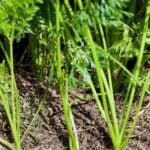Chinese vegetable gardening techniques have been practiced for centuries in China, showcasing the rich agricultural traditions and techniques honed over generations. This article delves into the history, climate, soil requirements, traditional vegetables, best practices, tools and equipment needed, pest and disease management, harvesting, and storage tips involved in Chinese vegetable gardening. With a focus on sustainability and self-sufficiency, Chinese vegetable gardening techniques offer valuable insights for modern gardeners looking to connect with nature and enjoy fresh produce.
Rooted in ancient agricultural practices, Chinese vegetable gardening techniques embody a harmonious relationship between humans and nature. The methods employed have stood the test of time and continue to be relevant today for their effectiveness and efficiency. From cultivating diverse varieties of traditional vegetables to optimizing the use of available resources, Chinese vegetable gardening emphasizes holistic approaches that benefit both the environment and the gardener.
Understanding the optimal climate and soil conditions is crucial for successful Chinese vegetable gardening. By paying attention to these factors and selecting suitable varieties of vegetables, gardeners can maximize their yields and ensure healthy growth. Whether it’s navigating through different regions’ unique microclimates or adjusting soil composition for specific crops, adopting these tailored approaches can make all the difference in a thriving Chinese vegetable garden.
History of Chinese Vegetable Gardening
The history of Chinese vegetable gardening dates back thousands of years, with the practice deeply rooted in Chinese culture and traditions. Chinese farmers have been cultivating vegetables for centuries, using time-tested techniques that have been passed down through generations. The art of growing vegetables in China has evolved over time, influenced by factors such as climate, geography, and dietary preferences.
Ancient Origins
Chinese vegetable gardening can be traced back to ancient times when agricultural practices were first developed in China. Early Chinese farmers experimented with various crops and farming methods to sustain their communities. These ancient techniques laid the foundation for modern Chinese vegetable gardening practices that are still used today.
Cultural Significance
Vegetable gardening holds great cultural significance in China, with certain vegetables being associated with luck, prosperity, and health. Traditional Chinese medicine also emphasizes the importance of fresh vegetables in maintaining overall well-being. As a result, Chinese vegetable gardening has become an integral part of daily life for many people in China, reflecting the country’s rich cultural heritage.
Continued Innovation
Despite its long history, Chinese vegetable gardening continues to evolve and adapt to changing conditions. Farmers are constantly experimenting with new varieties of vegetables and innovative growing techniques to improve yields and quality. The combination of traditional wisdom and modern agricultural methods has made Chinese vegetable gardening a sustainable and successful practice that continues to thrive in today’s world.
Climate and Soil Requirements for Chinese Vegetable Gardening
Chinese Vegetable Gardening Techniques thrive in a variety of climates, from temperate to subtropical regions. The key is to choose vegetables that are suitable for your specific climate and soil conditions. Some Chinese vegetables, such as bok choy, Chinese cabbage, and snow peas, prefer cooler temperatures and can be grown in the spring or fall. Others, like eggplants, cucumbers, and bitter melon, thrive in warmer weather and are best planted in the summer months.
When it comes to soil requirements for Chinese Vegetable Gardening Techniques, well-draining soil rich in organic matter is essential for healthy plant growth. Chinese vegetables benefit from soil with a pH level between 6.0 to 6.8. Adding compost or aged manure to the soil before planting can help improve its fertility and structure. It’s also important to ensure proper drainage to prevent waterlogged soil, which can lead to root rot and other diseases.
In addition to climate and soil considerations, sunlight is another crucial factor for successful Chinese vegetable gardening. Most Chinese vegetables require at least 6-8 hours of sunlight per day to thrive.
Be sure to choose a sunny spot in your garden or use containers that can be moved throughout the day to ensure your plants receive adequate sunlight. By paying attention to these key factors – climate suitability, soil quality, and sunlight exposure – you can create an optimal environment for growing a variety of delicious and nutritious Chinese vegetables using traditional Chinese vegetable gardening techniques.
Traditional Chinese Vegetables and Their Health Benefits
Traditional Chinese vegetables not only add diversity to your diet but also offer a plethora of health benefits. These nutrient-rich vegetables are an essential component of Chinese cuisine and have been cultivated for centuries. Some popular traditional Chinese vegetables include bok choy, Chinese broccoli (gai lan), water spinach (kangkong), and bitter melon. Here are some health benefits associated with these vegetables:
- Bok Choy: Rich in vitamins A, C, and K, bok choy is known for its anti-inflammatory properties and potential cancer-fighting abilities.
- Chinese Broccoli (Gai Lan): Packed with vitamins A, C, and K, as well as iron and calcium, gai lan promotes healthy bones, vision, and immunity.
- Water Spinach (Kangkong): High in antioxidants and fiber, kangkong aids digestion and may help lower cholesterol levels.
- Bitter Melon: Known for its blood sugar-regulating properties, bitter melon is a staple in traditional Chinese medicine for managing diabetes.
By incorporating these traditional Chinese vegetables into your diet, you can enjoy their unique flavors while reaping the numerous health benefits they offer. Whether stir-fried or steamed, these vegetables can be easily incorporated into various dishes to enhance both the taste and nutritional value of your meals.
Additionally, practicing Chinese vegetable gardening techniques can ensure that you have a fresh supply of these nutritious vegetables at your fingertips. From preparing the soil to selecting the right varieties to planting and caring for the crops, following traditional methods can lead to a successful harvest. By embracing the wisdom of Chinese vegetable gardening techniques, you can experience the satisfaction of growing your own healthy produce while maintaining a connection to ancient agricultural practices.
Best Practices for Chinese Vegetable Gardening
Chinese vegetable gardening techniques have been honed over centuries, resulting in bountiful harvests of nutritious and flavorful produce. To achieve success in Chinese vegetable gardening, it is essential to follow some best practices that have been passed down through generations. One key practice is selecting the right vegetables for your climate and soil conditions. Different regions may require specific varieties of vegetables to thrive, so it is crucial to understand the needs of each plant.
In Chinese vegetable gardening, proper spacing and placement of crops play a significant role in overall productivity. When planting Chinese vegetables, ensure that they have enough space to grow and receive adequate sunlight. Crop rotation is also a common practice in Chinese vegetable gardening, as it helps maintain soil fertility and reduces the risk of pests and diseases. By rotating your crops each season, you can maximize yields and minimize potential problems.
Furthermore, incorporating organic matter into the soil is paramount in Chinese vegetable gardening techniques. Adding compost or well-rotted manure can improve soil structure, moisture retention, and nutrient levels, promoting healthy plant growth. Additionally, utilizing mulch around plants can help suppress weeds, regulate soil temperature, and conserve moisture. These best practices not only benefit the current harvest but also contribute to long-term soil health in your Chinese vegetable garden.
| Key Practices for Chinese Vegetable Gardening | Benefits |
|---|---|
| Proper selection of vegetables | Thriving plants adapted to local conditions |
| Correct spacing and crop placement | Maximized productivity and sunlight exposure |
| Crop rotation | Maintained soil fertility and reduced pest/disease risks |
Tools and Equipment Needed for Chinese Vegetable Gardening
When it comes to Chinese vegetable gardening techniques, having the right tools and equipment can make a significant difference in the success of your garden. Here are some essential items you will need to effectively grow traditional Chinese vegetables:
- Hand tools: Tools such as a hand trowel, weeder, pruning shears, and gloves are crucial for planting, weeding, and maintaining your Chinese vegetable garden. These tools help you work efficiently while minimizing damage to the plants.
- Watering system: A reliable watering system is essential for keeping your Chinese vegetables healthy and thriving. Consider investing in drip irrigation systems or soaker hoses to ensure that your plants receive consistent moisture levels.
- Trellises and supports: Many traditional Chinese vegetables like cucumbers, bitter melon, and yard-long beans require trellises or supports for optimal growth. Bamboo poles or wire frames can be used to provide support and keep these plants off the ground.
In addition to these basic tools and equipment, consider incorporating other specialized items based on the specific needs of the Chinese vegetables you plan to grow. Proper care and maintenance of your tools are also essential to ensure their longevity and effectiveness in your garden.
Caring for Your Tools:
- Regularly clean and sanitize your gardening tools to prevent the spread of diseases among your plants.
- Sharpen blades on pruning shears and other cutting tools regularly to ensure clean cuts that promote plant health.
- Store your tools in a dry place away from direct sunlight to prevent rusting and prolong their lifespan.
By equipping yourself with the necessary tools and equipment for Chinese vegetable gardening, you’ll be well-prepared to cultivate a thriving garden filled with nutritious produce rich in flavor.
Pest and Disease Management in Chinese Vegetable Gardening
Pest and disease management is a crucial aspect of Chinese vegetable gardening to ensure healthy and bountiful harvests. By implementing effective strategies, gardeners can prevent damage to their crops and minimize the use of harmful chemicals. Here are some key practices for managing pests and diseases in Chinese vegetable gardens:
Companion Planting
One traditional Chinese technique for pest management is companion planting, which involves growing certain plants together to deter pests or attract beneficial insects. For example, planting garlic alongside leafy greens like bok choy can help repel pests such as aphids and caterpillars. Similarly, marigolds can be planted near vegetables like tomatoes to ward off nematodes.
Organic Pest Control
Chinese vegetable gardeners often rely on organic pest control methods to protect their crops without the use of chemical pesticides. This can include introducing natural predators like ladybugs or lacewings to eat harmful insects, using neem oil spray to repel pests, or creating homemade insecticidal soaps from ingredients like garlic and chili peppers.
Disease Prevention
To prevent diseases in Chinese vegetable gardens, it is essential to practice good crop rotation by alternating plant families each growing season. This helps reduce the build-up of soil-borne pathogens that can affect specific vegetables. Additionally, ensuring proper spacing between plants for adequate air circulation can help prevent fungal diseases like powdery mildew on crops such as cucumbers and squash.
By incorporating these pest and disease management techniques into their gardening practices, enthusiasts of Chinese vegetable gardening can maintain healthy and thriving crops while preserving the natural balance of their ecosystem. Taking a holistic approach to pest control not only benefits the environment but also promotes sustainable gardening practices for future generations.
Harvesting and Storage Tips for Chinese Vegetables
Harvesting and storing Chinese vegetables properly is crucial to maintaining their flavor, texture, and nutritional value. When it comes to harvesting Chinese vegetables, timing is key. Most varieties are best when harvested young and tender. For leafy greens like bok choy and Chinese cabbage, it is recommended to pick them when they are still crisp and vibrant in color. This not only ensures optimal taste but also encourages the growth of new leaves for future harvests.
Additionally, having the right tools for harvesting can make a significant difference in the quality of your produce. Sharp scissors or pruning shears are ideal for cutting leafy greens without damaging the plant. For root vegetables like daikon radishes or carrots, a digging fork or trowel can help gently lift them from the soil without causing any harm.
When it comes to storage, Chinese vegetables have different requirements based on their characteristics. Leafy greens should be stored in a perforated plastic bag in the refrigerator’s crisper drawer to retain moisture while allowing airflow. Root vegetables like turnips or radishes can be stored in a cool, dark place with high humidity to prevent wilting. Properly storing your harvested Chinese vegetables ensures that they stay fresh longer and maintain their nutritional value.
Incorporating these harvesting and storage tips into your Chinese vegetable gardening routine will not only help you enjoy a bountiful harvest but also preserve the flavors and nutrients of these nutritious vegetables for longer periods of time. By paying attention to these details, you can truly embrace the wisdom of traditional Chinese vegetable gardening techniques that have been practiced for centuries.
Conclusion
In conclusion, Chinese vegetable gardening techniques offer a rich history and valuable insights that can benefit gardeners of all levels. By understanding the traditional practices, climate and soil requirements, as well as the health benefits of Chinese vegetables, individuals can cultivate a bountiful and nutritious garden. Embracing these techniques not only provides an opportunity to connect with ancient agricultural wisdom but also promotes sustainability and self-sufficiency.
The emphasis on natural methods of pest and disease management in Chinese vegetable gardening highlights the importance of working in harmony with nature. By utilizing tools and equipment suited for this purpose, gardeners can minimize the use of harmful chemicals while maintaining healthy crops. Furthermore, adopting harvesting and storage tips specific to Chinese vegetables ensures that the produce retains its flavor and nutritional value for longer periods.
In essence, Chinese vegetable gardening techniques offer a holistic approach to cultivating a thriving garden that goes beyond simply growing plants. The integration of traditional knowledge, sustainable practices, and respect for nature allows individuals to not only enjoy fresh produce but also appreciate the heritage behind each seed sown.
By incorporating these time-honored methods into modern gardening practices, we honor the legacy of Chinese agriculture while reaping the benefits of nourishing our bodies and souls through the fruits of labor in our own backyard.
Frequently Asked Questions
What Vegetables Grow in China?
China is known for growing a wide variety of vegetables, including cabbage, bok choy, Chinese broccoli, snow peas, Napa cabbage, and daikon radish. These vegetables are commonly seen in Chinese cuisine due to their availability.
What Chinese Vegetables Grow in Water?
Some Chinese vegetables that can be grown in water include water spinach (kangkong), watercress, and lotus root. Water spinach and watercress are water-loving plants that thrive in aquatic environments, while lotus root can be grown hydroponically.
How Do You Harvest Chinese Vegetables?
Harvesting Chinese vegetables usually involves picking the vegetables at their peak freshness and maturity. For leafy greens like bok choy and Chinese broccoli, it’s best to harvest them when the leaves are crisp and vibrant without any signs of wilting or yellowing.
Root vegetables like daikon radish should be harvested once they reach a desirable size but before they become too woody or tough. In general, it’s important to handle the vegetables carefully during harvest to avoid any damage that could reduce their quality or shelf life.

If you’re looking to get into vegetable gardening, or are just looking for some tips on how to make your current garden better, then you’ve come to the right place! My name is Ethel and I have been gardening for years. In this blog, I’m going to share with you some of my best tips on how to create a successful vegetable garden.





